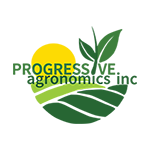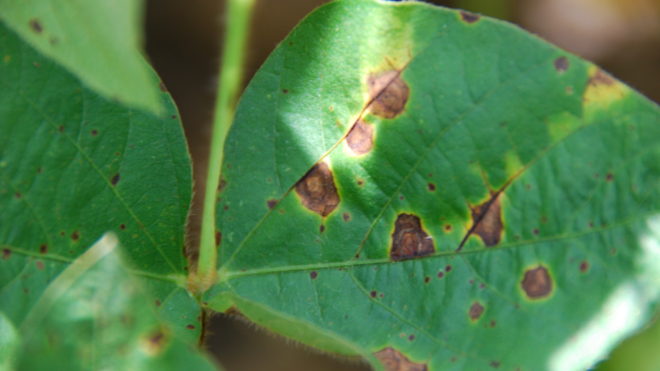Target Spot is not a new disease but has become more of an issue in the past few years, especially in the southern regions of our marketing area. Historically, it has not been a yield-robbing disease because it typically remains in the lower canopy of a soybean plant, and those leaves do not contribute to overall yield. In 2014, pathologists began seeing more severe infections, and by 2016 it was considered a disease with significant yield impact in susceptible varieties.
Target Spot is caused by the pathogen Corynespora cassiicola, and, if left untreated, has the potential to cause significant yield loss. It is often confused with other foliar diseases, such as frogeye leaf spot and Septoria brown spot because of its large circular lesions. This pathogen can infect over 300 other host crops, including cotton and tomatoes. However, it is not the same pathogen that causes target spot in grain sorghum. It can overwinter in the soil or on infected debris on the soil surface. Symptoms usually begin in the lower canopy and, depending on the susceptibility of the soybean variety, will work its way up through the canopy. Lesions will be large (1/4 in. to 1/2 in.) and circular with concentric rings.
This is how the disease got its name, target spot. Lesions will also have a chlorotic or yellow ring around the infected area. As the disease progresses through the mid and upper canopy, the lesions typically shrink in size (1/16 in. to 1/8 in.), but not in appearance.
Severe infections may cause leaves to abscise or drop from the plant. Prolonged periods of high relative humidity (> 85%), leaf wetness, and warm temperatures favor disease progression.
Estimating yield loss from the disease is difficult. However, calculating defoliation by growth stage can estimate yield loss potential — 50% defoliation (from lower canopy) between R3 and R5 equates to approximately 10% yield loss, while 60% at R6 is only 5% yield loss. While the disease has been extensively studied in cotton, there is still a need for research in soybeans to better understand and manage the disease. FARMserver® has a soybean defoliation tool that will help you evaluate percent defoliation and estimated yield loss.
The lack of foliar fungicide trials specifically targeting this pest makes recommendations for control difficult. However, there are a few fungicides on the market that show promise in suppressing the disease. Fungicides with the active ingredients pyraclostrobin (a component of Priaxor® and Revytek™) and prothioconazole (a component in Stratego® YLD and Delaro®) have been effective at controlling target spot. Cultural practices such as crop rotation to a non-susceptible host like corn or grain sorghum can also be effective at reducing inoculum. It is important to remember that the disease can survive on infected residue for up to two years.
Target spot can often be found in the lower canopy of soybean fields and causes very little to no yield loss. It becomes noteworthy once it moves to the middle or upper canopy. Continue to scout fields and take appropriate action as needed. Contact your local Beck’s representative to learn more.
~ Austin Scott, CCA – Field Agronomist

